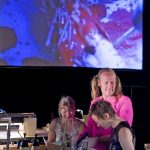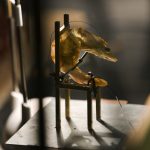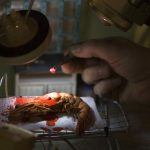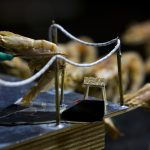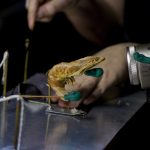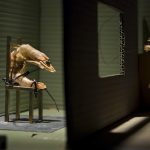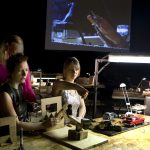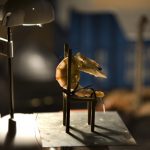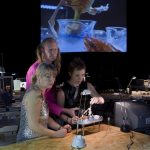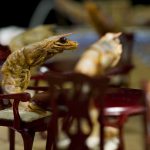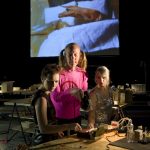


- Plays this season
- Premiere Year 2009
In Shrimp Tales, Hotel Modern attempts to portray the fascinating plague that calls itself Humanity. We observe people as if they belonged to an exotic species with unique characteristics. They play sports, practice science, strive, live, make love and loose their mind.
Shrimp Tales is a kaleidoscopic portrait packed with significant and insignificant moments: life, death and the frantic scrabbling around in between. In Shrimp Tales, shrimps play the roles of humans.
"You can love, you can be moved and at the same time you can be astonished by the exquisite way in which it is made." (Volkskrant)
"Shrimp Tales may initially come across as light, but it is a wilful, comical and thoroughly well-conceived work, an absolute must-see." (Theaterjournaal)
"On stage is an extensive array of miniature sets on tables. And this is where the shrimp drama unfolds, crisscrossing from left to right, from foreground to background, the images from the finger-sized video cameras sending their images to the large screen at the rear. Composer Sauer is on the spot, creating the live soundtrack; sometimes suitable, sometimes disconcerting." (Trouw)
"You can gape in wonder endlessly at the way the scale models have been built. We see births, deaths, disease, poverty, a boxing match, brain surgery, a moon landing, a rave, two tramps on a garbage dump, people going out to eat, a flower seller killed with a pair of scissors, the execution of a condemned man, and so on." (NRC Handelsblad)
"The creatures are so photogenic that one is immediately drawn into the stories: from the hysteria of a boxing match to the stillness of a rainy day on a campsite; from the first cuneiform script to the landing on the moon. The shrimps live through it all and mirror human life back at us, drenched as it is in delusion and loneliness." (AD Rotterdams Dagblad)
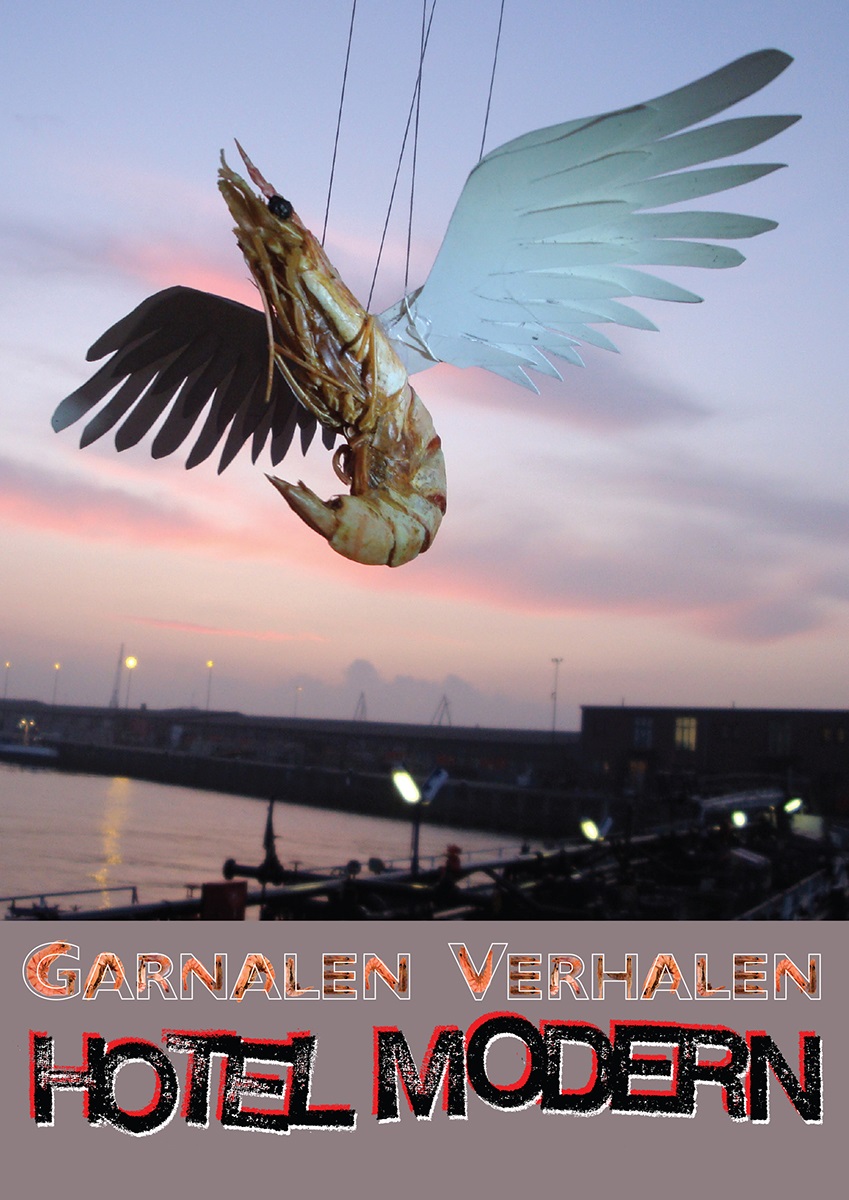
-
Reviews & articles
-
Hotel Modern observes humanity using shrimps (interview)
Arlène Hoornweg: 'Shrimps are very photogenic. They have expressive eyes and a cute quiff. They exude a certain curiosity. They serve well both as a human figure and as an animation puppet.'
by Dijlan Van Vlimmeren, AD Rotterdams Dagblad Read the whole review
A shrimp at the operating table cuts out a patient’s brain tumour. A shrimp proposes marriage to his sweetheart; a shrimp in a boxing ring knocks out his opponent: scenes that are as absurd as the are familiar.
The Rotterdam theatre company Hotel Modern observes humanity through the shrimp. As Pauline Kalker from Hotel Modern points out, ‘In the performance Shrimp Tales we depict humanity with all its charms and shortcomings. Humanity is a very busy species. We have to go to the moon, we have to do sports, we have to do so much,’
As Herman Helle, Kalker’s partner, sees it, humanity is a fascinating plague. ‘Humanity makes huge demands when it comes to establishing its position on this world.’
Why use the shrimp is a symbol for humanity? Arlène Hoornweg, the third member of the trio answers, ‘Shrimps are very photogenic. They have expressive eyes and a cute quiff. They exude a certain curiosity. They serve well both as a human figure and as an animation puppet.’
In the tragicomic performance Shrimp Tales the shellfish make love, go camping in a tent in the pouring rain, play a game of billiards and watch Antiques Roadshow. We do not see them, however, in the conference room (‘Boring for the audience to have to watch’) or on the floor of the stock exchange. ‘There is nothing about the credit crisis. We don’t allude to anything topical,’ says Herman Helle. ‘We make one exception in the case of the shrimp weatherman. We try to gear forecasts to reality. If it’s freezing outside, he’s not going to predict a heat wave.’
The scenes could be set in Rotterdam: shrimps go wild to Gabba music, for example. ‘But none of the shrimps answer to the name Jules Deelder,’* says Kalker, setting the record straight using a familiar figure from the city on the Meuse.
The shrimps vary in size, but hardly at all in colour. Does Shrimp Tales overlook our multicultural society? ‘We only make a distinction in age and gender,’ says Hoornweg, ‘We use our voices to make it clear to the audience whether it is a male or female shrimp that is going to be opened up, or whether the murder was committed by a male or a female shrimp.’
The ingenious set consists of 53 miniature locations and a film screen. Helle, Hoornweg and Kalker track past the shrimps with a finger-sized camera. On the screen, the audience can follow events at the various locations.The audience does not get to eat the approximately 350 actors at the end. As the makers explain, ‘The shrimps are dried for about ten minutes in a microwave. There is nothing but powder in the shell. They are also hardened with epoxy and varnished. We wouldn’t advise anyone to put them in their mouth’
Hotel Modern are unconcerned about possible criticism from the parliamentary Animal Party. ‘At a meal, only one person gets to enjoy the shrimps; the way we do it, they give pleasure to entire audiences,’ explains Pauline Kalker.
*Jules Deelder (1944) is a renowned poet-performer from Rotterdam
02-02-2009
-
This performance is as unique as it is universal
The creatures are so photogenic that one is immediately drawn into the stories: from the hysteria of a boxing match to the stillness of a rainy day on a campsite; from the first cuneiform script to the landing on the moon. The shrimps live through it all and mirror human life back at us, drenched as it is in delusion and loneliness. (NL newspaper AD Roitterdams Dagblad)
by Hans van Dam, AD Rotterdams Dagblad Read More
The Rotterdam-based theatre group Hotel Modern has been working away at a unique concept for around ten years. With the help of ingenious miniature sets and finger-sized cameras, they produce video images that they project live on stage. The audience sees both the process of creation and the final result.
There are no limits to the animated world they evoke: subjects range from erotic abandon to the inhumanity of Auschwitz; all painstakingly and lovingly made by hand and brought to life. In the new performance Shrimp Tales this technique reaches new heights. The complex manoeuvrings around the miniature set, including a live soundtrack maker who accompanies the projected images, have achieved such a powerful sense of rhythm and conviction that a truly unified whole comes into being.
It was also an inspired and brilliant idea to use shrimps to represent humanity in all its complexity. The creatures are so photogenic that one is immediately drawn into the stories: from the hysteria of a boxing match to the stillness of a rainy day on a campsite; from the first cuneiform script to the landing on the moon. The shrimps live through it all and mirror human life back at us, drenched as it is in delusion and loneliness. This eternal theme of human impotence is expressed marvellously at the end of the play by the winged shrimps that return to a room full of incubators, where the newborn baby shrimps hanker for their goal in life. This performance is as unique as it is universal.
11-02-2009
-
Shrimp of few words on rain-drenched camping site
On stage is an extensive array of miniature sets on tables. And this is where the shrimp drama unfolds, crisscrossing from left to right, from foreground to background, the images from the finger-sized video cameras sending their images to the large screen at the rear. Composer Sauer is on the spot, creating the live soundtrack; sometimes suitable, sometimes disconcerting.
by Arend Evenhuis, Trouw Read More
These are not the fragile, pea-brained creatures we might have expected. Instead, the shrimps taking the lead roles in Hotel Modern’s latest production step forward, keen and intrepid, and with well-rehearsed dialogue, too.
One might not have expected the shrimps to be so at ease with their lines, because in the Hotel Modern’s cinematic raree-show theatre, dialogue is generally absent.
Previous productions by Pauline Kalker, Arlène Hoornweg, Herman Helle and sound composer Arthur Sauer include performances about the misery of the trenches and concentration camps and the vast subject of lust, in a Biedermeier setting. Now it is time for a parable. A parable about shrimps who seem to behave as arbitrarily as humans. After two turns in the microwave literally hardened them to the theatre trade, the shrimps were cast for their roles: ‘Some shrimps are melancholy, some are stalwart.’ And this is demonstrably true.
On stage is an extensive array of miniature sets on tables, a kind of marshalling yard. And this is where the shrimp drama unfolds, crisscrossing from left to right, from foreground to background, the images from the finger-sized video cameras sending their images to the large screen at the rear. Composer Sauer is on the spot, creating the live soundtrack; sometimes suitable, sometimes disconcerting.
The shrimps have rather a lot to attend to. They visit the Antiques Roadshow en masse to find out how many of the pieces of furniture they have carried on their shrimp backs deserve to called ‘antique’; they go to the zoo and to the miniature city, weddings, funerals, hospitals and prisons – here they wait, stoically, for the electric chair. They watch a weather report presented by a fellow shrimp (‘When the Germans sent their depressions our way’). And they hang around in garages, where doors are confidently welded on to cars with the torrent of sparks from a firework.
Hotel Modern’s predilection for squalor and obscenity passes the review rather too extensively (deafening drilling during surgery to remove a shrimp tumour, exorcists rolling around in vomit), but this is counterbalanced by plenty of skillfulness and playful inventiveness – although the actors do have rather a lot to say in this shrimp drama.
I actually found the scenes without dialogue the most affecting: the shrimps slogging away at the draughts board, the hiss of the rolling cardboard sea by moonlight, the indefatigable fisher-shrimp in his wheel house in a gale force wind, the three astro-shrimps on the moon and the Edward Hopperesque visit to the carwash and the equally dismal diner with no shrimp snacks. And, of course, the camper shrimp gazing out from his tent, patiently waiting for the rain bombarding his shelter to cease.
And is it disastrous that there is not even a suggestion of a link between these scenes that tumble into and over one another? Well, perhaps it is simply a functional way of drawing our attention to the fact that shrimps stumble through their lives just as doggedly, aimlessly and desperately as humans.
11-02-2009
-
Mourning at the funeral of a recalcitrant shrimp drifter
A mosaic performance with shrimp characters that meet each other and lose touch; sad, strange and beautiful stories of trembling pink bodies and melancholy beady eyes, whom we recognise and become attached to - and for whom we can mourn at a funeral.
by Karin Veraart, Volkskrant Read More
It begins with a funeral. In the ceremony room, two shrimps prepare for the event. They carefully inspect the impersonal space with its inevitable ‘artwork’. They contemplate the artwork and muse upon it until it suddenly takes on a life of its own. And one shrimp says to the other, ‘Yes, indeed. Very modern.’
That, then, is a Shrimp Story – or an example of one. This one has not yet reached its conclusion, when the focus shifts briefly to a maternity room, where a shrimp is giving birth. From there it moved along to a rubbish belt with shrimp tramps, to a cafe where a shrimp tries to hawk roses to uninterested shrimp clients, and to a petrol station, an exorcism, a boxing match, a discotheque, a wedding and a zoo – there’s nothing you can imagine that shrimps don’t get up to… that we don’t get up to. Or is it the other way round?
Shrimp Tales, the latest work by Hotel Modern, is another in the best tradition of this trio, one that has gained in prominence over the last ten years by developing its very own theatrical form. In productions by Hotel Modern visual arts, animation, music, performance and a special filming technique are brought together in a truly singular way. They take scenes from the Great War, Auschwitz, the battered Twin Towers, and other, apparently everyday, events, and stage them beautifully, with humour and compassion.
And so one could watch for hours as shrimps do things one would generally think were reserved for humans. One can laugh, one can be moved and at the same time one can be astonished by the exquisite way in which it is made. On tiny table stages, the three deviser-actors draw together an incredible variety of objects and manipulate them to create a scene – sometimes using a video camera, sometimes not. These are transformed into films projected onto a screen at the rear of the stage; the theatre takes place on the stage, where the actors dart nimbly from table to table, each awaiting the telling of its own story.
Shrimp Tales is, then, a mosaic performance with shrimp characters that meet each other and lose touch; sad, strange and beautiful stories of trembling pink bodies and melancholy beady eyes, whom we recognise and become attached to – and for whom we can mourn at a funeral.
11-02-2009
-
Life on Earth by hundreds of shrimps
You can gape in wonder endlessly at the way the scale models have been built. We see births, deaths, disease, poverty, a boxing match, brain surgery, a moon landing, a rave, two tramps on a garbage dump, people going out to eat, a flower seller killed with a pair of scissors, the execution of a condemned man, and so on.
by Wilfred Takken, NRC Handelsblad Read the whole review
‘Test, test, test…,’ says the funeral director, a hunched-over shrimp wearing a top hat. His colleague sweeps the floor and comments on the dusty macramé wall hanging: a typical crematorium art work, even if the shrimps do love it. The next of kin wait in a room next door. Just before they enter, the camera leaps to a maternity ward where a child is being born. A baby shrimp lies in a pool of blood.
This prologue of a cremation is also the prologue of Shrimp Tales in which Hotel Modern play out fifty short scenes from life on Earth – in one hour. Uniquely, the roles are taken by three hundred dead shrimps.
Hotel Modern make a unique form of object theatre. They project live animation film; you can watch the film and simultaneously see it being made. Ingeniously constructed miniature film sets stand atop tables: an electric chair, a boxing ring, an operating theatre and so on. Members of the cast walk among these sets with cameras, filming the scenes and projecting them on the screen. Three, sometimes four, actors stand over the scale model and use wires to manipulate the shrimps, scenery and props, while on the left of the stage a virtuoso Foley artist creates a live soundtrack.
These puppeteers used similar techniques for The Great War, about the First World War, and Kamp, about Auschwitz. As a respite from these doom-laden themes, they then went on to make Rococo, pornography with Biedermeier statuettes. The Great War is their masterpiece, because it is here that form and content are in perfect balance and the collision between the two results in a gripping experience. In The Great War it is all about the field of tension between the epic, dark story and the tinkering about in the world of playthings, and about the sensational results that end up on the screen. In other performances form takes precedence. Kamp is more of an installation than a work of theatre.
Technically speaking, Shrimp Tales is their most ambitious project, given the large number of short scenes that have to be set in rapid succession. It is also ambitious with respect to content, because it is life itself that they want to capture. We see births, deaths, disease, poverty, a boxing match, brain surgery, a moon landing, a rave, two tramps on a garbage dump, people going out to eat, a flower seller killed with a pair of scissors, the execution of a condemned man, and so on.
You can gape in wonder endlessly at the way the scale models have been built, with matchboxes as petrol pumps and a cast-off computer part as a spaceship. When it is over, the audience is invited to walk around the stage and take their time inspecting the miniature sets. There is no overarching story. Most scenes consist of a fascinating tableau taken from life. This sometimes comes across as being somewhat arbitrary, and one might sometimes wish they had added some more dialogue or given it a more personal twist. The best scenes are the ones in which they do this.
The high point is the darkly absurd episode of the TV programme Antiques Roadshow combined with an autopsy. We see shrimps standing in line carrying tiny paintings or dolls house furniture on their back. The one at the front has brought along a corpse. The connoisseur expertly assesses the body of the doll (not a shrimp in this case): ‘It is a girl aged about thirteen – in absolutely perfect condition. There’s just a little damage between the legs.’ He can tell from the ant eggs at the hair follicles that she has been dead for a few weeks. The man who brought the girl’s body found her in a ditch behind her house. The connoisseur estimates her value to be between 15,000 and 20,000. A similar comical combination of genres is used in a scene with echoes of Liaisons Dangereuses. A tax consultant in an 18th-century set write a letter to a countess, and it is this setting which gives an amorous charge to the dry financial correspondence.
In a film that can be viewed on Hotel Modern’s fantastic website (along with another film, about 9/11, in which they use apple juice cartons for skyscrapers) the makers explain that they used shrimps because they want to observe humanity as a species of animal.
In the final scene, the scale models have been deserted and winged shrimps glide overhead. As in the film Wings of Desire, they look down with compassion on human struggles.
11-02-2009
-
Tourdates Shrimp Tales
- Saturday 6 June 2026 De Maagd Bergen op Zoom NL
- View all our tourdates in the agenda
-
Makers
-
Makers and performers Pauline Kalker, Arlène Hoornweg, Herman Helle Sound concept and live performance Arthur Sauer Set assistant and live set dresser Ineke Kruizinga Technicians André Goos, Joris van Oosterhout Assistants Heleen Wiemer, Stefan Gross, Jozef van Rossum, Sanne Vaghi, Jan-Geert Munneke, Annette Scheer Flyer and poster design Ralph Prins, Sibe Kokke/notdef Subsidy Performing Arts Fund NL, City of Rotterdam With thanks to Els Nieveen van Dijkum, Wilco Kwerreveld, Amnesty International




